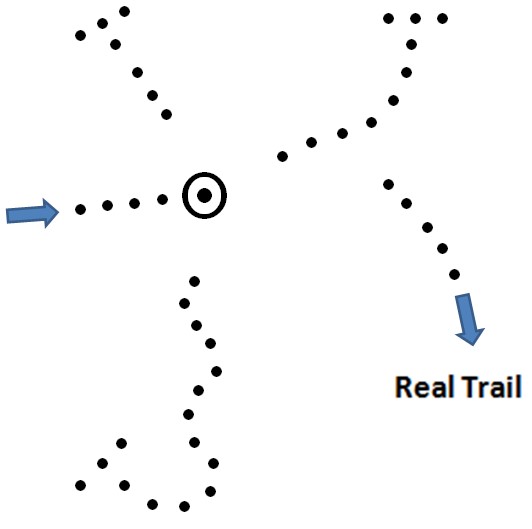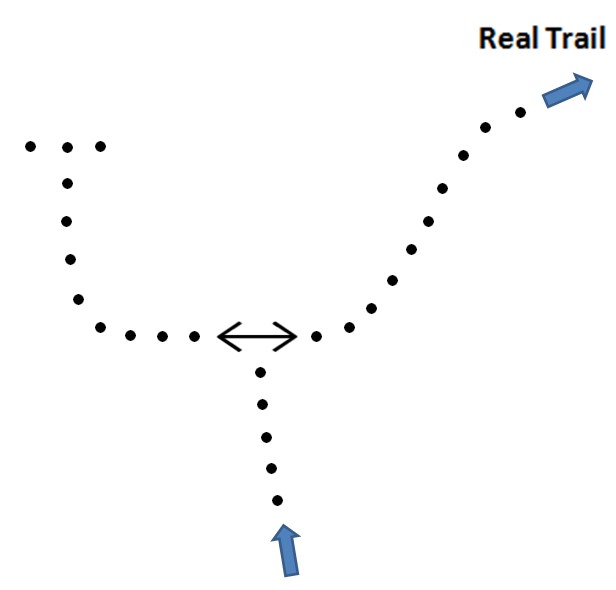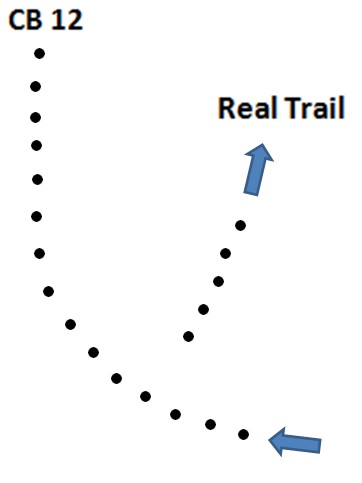Costa Blanca HHH Manual of Haring
(How To Set a Bloody Good Trail)
Introduction
Download PDF
Every week a trail appears, as if by miracle, in the countryside or streets in the Costa Blanca area for the Hashing pleasure of the Costa Blanca Hash House Harriers (CBH3). You'll be surprised, nay, flabbergasted, to know that Hashers actually volunteer for the privilege to “hare” i.e., to set one of these ingenious trails, replete with their own indecipherable symbols and lore. You've stumbled around the trail a few times, each time, somehow, ending up back where you started. And now you'd like access to the inner sanctum and the Hashing equivalent of “The Knowledge” and you want to be one of them … a HARE!
This manual contains guidelines on how to set a Hash trail. These guidelines are not set in stone, but following them will make it easier for you to avoid many of the pitfalls which have befallen inexperienced (and some experienced) Hares. Hopefully these will make your life easier and help you to organise a superb day of Hashing for everyone.
In order to have a good idea of what Hashing is all about, a Hare should have run several Hash trails before attempting to set one. Furthermore, it's a good idea – essential, actually – for virgin Hares to set their first couple of runs with an experienced Hare to show them the ropes.
Before you start
First, let's get a few basics out of the way. You want to hare a trail but you've got no idea whatsoever what to do or when to do it. Before you start the process of haring, there are a few things you should know:
- I've run a few Hashes and I really, really want to hare a run... what should I do? Easy! Put your name forward to the Hareline Coordinator and choose a date among those available.
- But I don't have anyone to hare with me… Ask around; if nobody's forthcoming, the Hareline Coordinator will pair you up with someone. Ideally a trail should have two Hares, although with experience you'll be able to set one on your own if you want to. Although possible, we discourage more than two Hares setting a normal run.
- I don't have a car so how can I set a run? Not a problem. Pair up with a co-Hare who has a car. Or you may even have a fantastic trail sitting outside our front door. If you're still at a loss, ask some of the experienced Hares; they'll be able to suggest potential sites.
- Ok, I've signed up to set a run… Now what? You'll now need to buy or pillage a few items before you set it. At Costa Blanca we set runs with a mixture of flour and chalk (see later notes on flour warnings) so you'll need to buy some – enough for the entire trail, to mark the Car Park (which you should mark "CP" or "HHH CP"), the arrows on roads and tracks leading to the Car Park, etc. If laying the flour by hand, consider about 1+ kg of flour per kilometre of trail where flour is used. If you are using a flour dumper (which you'll have to make yourself or commandeer) you could need considerably less. You will also need a pack to carry the flour, and maybe some water if the weather's hot. Take a mobile to contact people if you're late, lost or lonely.
- I have to buy my own flour to set the run? That's a bit unfair isn't? Aha! Fear not. In its magnanimous generosity and as a reward for your heroic haring efforts, the CBH3's policy is that you don't pay a Hash fee when you hare. That only applies to two Hares though. Don't go thinking that, if you have 10 Hares, they'll all be getting a free ride…
- What about the Beer? Do I have to buy the Beer? Nope! Beer appears on Sunday runs as if by magic. In other words it's brought by the Drays.
Brilliant! You're now all geared up and ready to roll.
Patience young Jedi…
|
First of All – An Important Note About Using Flour Over the past couple of years there have been a number of incidents around the Costa Blanca area where dogs have been poisoned by a deposit resembling flour. There are obviously certain risks involved when a Hare is laying something which the layman might assume to be something more sinister than a run marker. The CBH3 is still formulating its trail marking policy at the time of writing but the latest conclusions seem to be: - Use chalk markings in urban areas or near countryside properties - Use flour in wooded and remote areas – especially where chalk cannot be marked. We have been experimenting with coloured flour recently … maybe sawdust - so watch this space. |
Choosing a Car Park
The run should start from a location that is accessible by car. Remember that the Beer Dray needs to get the drinks to the site by car, so avoid areas where the Dray has to lug coolers considerable distances to get them to the circle or out of sight of a road. Evidently, don't place the Car Park (or CP) where it is illegal to park or where drivers will face fines for leaving their car.
The Car Park should be suitable for a number of purposes: parking the cars, having sufficient space for a circle, shade in summer, bushes available to satisfy the call of nature, having a reasonably attractive area for a picnic in summer, etc. Obviously, the more picturesque the better, but we've set runs in all kinds of locations and in all terrains over the years.
Take into account that some Hashers choose not to do the run, some may be injured, lazy, or merely wish to stay in the Car Park. Do not therefore place a Car Park on a street corner or on the hard shoulder of a motorway where those Hashers will have to endure two hours of incessant traffic. Hashes are meant to be pleasant days out for everyone, so make the effort to choose an appropriately pleasant Car Park.
Once you've chosen a Car Park, you should provide directions to the site, GPS coordinates, a map from Google Maps indicating how to get there from MJavea and, if possible, details of public transport to the site. All directions must be clear to enable everyone to get to the run site without confusion by car and should be emailed to the Hareline Coordinator by the Wednesday before the run. Although your directions are clear, you'll still have to lay flour or chalk arrows pointing into dirt tracks, or maybe even on approach roads and roundabouts (it's not advisable to prance about too long on the hard shoulder of main roads laying flour though). Provide directions and other information on the basis that you're telling half-witted Hashers who have no idea where you're telling them to go.
|
Note About Drinking in Public in Spain Unfortunately, current realities in the Spain are such that it is illegal for members of the public to drink alcohol outdoors in public places (the law makes reference to the "vía pública", which is pretty much anywhere that's public property, including roads, parks, tracks, and a very long etc.). Offenders potentially face fines of €600 per person. We should not encounter many problems in the countryside, on a dirt track in the middle of nowhere. Setting a run in urban areas is fine in principle, but Hares should be very careful when choosing a Car Park and must ensure that there is an area where the circle will be hidden from roads and the prying eyes of local law enforcement… We cannot – repeat, cannot – drink Beer freely on city streets and pavements anymore! As the Hare you are responsible for ensuring that no harm befalls the Hash or fellow Hashers on your run! |
Recceing and planning the trail
When taking the responsibility of being a Hare (and a responsibility it is… many people depend on you for a good day out) you should know exactly where the run is going to go before you set it. This means that you should recce (i.e., scout) your proposed trail at least once or twice before laying it. One of the recces should be at about the time of day at which your actual run will take place to avoid unpleasant surprises (e.g. hunting parties, bulls in fields, etc.). Even if you have set a run in an area before, it's still a good idea to recce the trail again as fences might have been erected since the last time you were there. Recceing the trail by Google Earth can be a recipe for disaster as you cannot see fences, gates or other obstacles that might impede your progress.
A trail should be of about 5-6 km for Walkers and BRBs and a maximum of about 10 km for Runners and FRBs, depending on the terrain. If the main Runner's trail is at the longer end of that range or even longer, consider including Runners – marked "R" – and Walkers – marked "W" – trails, effectively allowing "Walker" Hounds to take a shortened version of the run if they wish to do so. As a rough guide, if it takes two hours to set the final trail, then it should take the average Hound an hour to run it. Don't forget, if you are forced to walk when setting the trail – e.g. climbing a steep hill – Hounds can't run either so it will take them the same time to run that part of it.
Trails can be A to B (starting at one location and ending at a different location) or A to A (starting and ending in the same place). The vast majority are A to A as they are easier to organise; A to B runs are a logistical nightmare, requiring some kind of transport back to the Car Park, or outward transport in order to run back to the Car Park.
Trails can also be "live trails" (the Hares set off 15 minutes before the Hounds, who then attempt to catch the Hares) or "dead trails" (the Hares set the entire run before the Hounds set off). Again, the vast majority (on the Brunken Bull H3 anyway) are dead trails as they are easier to plan and execute. Live trails require greater knowledge of an area and greater fitness as Hares will have to outrun (and outfox) the Hounds while carrying flour.
A good trail will have variety. That means it should have some bits where you have to climb, crawl, walk, clamber, wade etc. but it will also have parts where you can just run unimpeded. Hills are good in moderation, as are rivers and railways, but too many are as bad as none. If possible, try to include a little of everything: dirt tracks, a little shiggy, cross country, a hill or two, maybe a stream, plenty of trees for shade in summer...
Main roads should be avoided whenever possible. In particular, try to avoid placing Checkpoints on or close to a road to avoid having the pack milling around in the traffic and people not being able to hear others call above the noise of traffic.
Setting the trail
It is vital that you make sure that you have enough time to set the trail. You don't want to be in the middle of a forest or half-way up a mountain one hour away from completing the run with only 15 minutes left until it is due to start – normally 14.00 for runs in winter months and 16.00 for summer runs. Recceing the run properly will give you a good indication of how long it will take to set it, how long it will be, etc. Then, to be on the safe side, add an extra hour… you have to factor in setting false trails, Checks, Check-Backs, False Trails etc. as well as unexpected problems that could arise while laying the trail (flooded rivers forcing you to change the planned route, etc.).
The trail should be laid clearly, with plenty of chalk (for urban areas) and flour (for more isolated spots). Both types of markings should be clear enough to see and shouldn't be too far apart. What's "too far" will depend on the terrain. For example, whereas it's acceptable to have markings 50 metres apart on a road or track, in high grass it will be nigh-on impossible to follow. The markings you are setting should ideally be visible from the previous blob, or it should be obvious where the run is going so Hounds don't have to stop every 50 metres to search for flour again. If flour can't be seen on the ground due to grass or because it's very wet, consider placing it on rocks, cow pats, tree trunks… anywhere where the Hounds will be able to see the trail. Also take into account that blobs in the very centre of a track are more likely to be rubbed out by cyclists, motorcyclists, cars, other runners, so placing it on one side is probably better.
It's quite legitimate occasionally to make a sudden left or right turn from the trail. If the Hounds don't realise, they should have been paying more attention. When they eventually realise they're not on flour, they will return to the last blob and resume their run.
Confounding the FRBs
An ideal trail keeps everyone together for most of the run and has all the Hounds back at the Beer within 15 minutes of one another. This means that, as a Hare, your job is to ensure that FRBs (Front Running Bastards) and the BRBs (Back Running Bastards) remain as close together as possible throughout the run.
Hares are able to hinder the progress of the FRBs in several ways, allowing the pack and slower Hounds time to catch up. However, each one of the tools available has a different effect and Hares should consider this when they use them. A good, long trail could well contain five or more Checks, Holds, Splits, etc., but the more you have the greater the chance of keeping the pack together.
Checkpoints(marked by a circle with or without a dot in the middle): Checkpoints, or Checks, are the most commonly used form of holding up the FRBs. Checks are best placed in areas where there are plenty of places to look, like open spaces or track junctions with several possible options. Two or more trails should be laid within 100 metres of a Checkpoint, one of which will be the real trail. All the other trails, which are false trails, or Falsies, are intended to lead the FRBs astray and will end in a "T" across the trail. A Falsie can be 200 metres' long, or longer depending on your penchant for sadism, but within reason. Try to plan it so the Hounds will find the Falsies before they find the real trail, for example by starting Falsies closer to the Check than the real trail. However the real trail shouldn't be completely impossible to find. The aim is to slow the FRBs down, not to get Hounds lost or have them searching for the real trail for half an hour. If you're running out of time, tired or downright lazy, you have the option of just setting a real trail, without Falsies. The last Checkpoint of the run should be a particularly good one. It should bring the pack together again for a flat or downhill run in, giving everyone a chance to stretch their legs. |
 |
Split Trails(marked by two – or more – arrows pointing in different directions): on a Split Trail flour is laid immediately off both arrows, but one of the trails will be false. While this is useful if you come to a two-way fork in the road (thus not making it convenient for a Checkpoint as it is obvious what limited routes will be taken), the effect will not be to bring the pack together. The FRBs who choose correctly and take the true trail will effectively be given a head-start over those who have taken the Falsie. It's therefore a good idea for a Split Trail to be followed shortly by a Check or a Hold to bring the pack back together again. |
 |
Check-Backs(marked by a circle with an "X" in the middle, or CB, both followed by a number): a Check-Back means that the real trail has deviated from the trail a number of dots earlier. The FRBs will have to run back along the trail for the number of dots indicated on the Check-Back and then look for a trail in any direction from that point. Although a Check-Back can be placed anywhere in open country, it's especially useful if the only option is to take the trail off a closed-in track at a tangent but you still wish to hinder the FRBs. The effect is that the FRBs will have to run the extra distance and will ultimately run back towards the oncoming, very thankful, pack |
 |
Hold Checks(marked by "H" in a circle): if a particular location doesn't allow for a Check or a Check-Back, another way to keep the pack together is by including a Hold, or Halt. Hounds are not supposed to leave the Hold before all the other Hounds have arrived (not the walkers though). Alternatively, you can choose only to hold up a certain number of the FRBs by adding a number to the Hold, indicating how many Hounds have to be there before the pack can continue. On the Costa Blanca H3, Beer Stops are also Holds, so nobody leaves the Beer Stop until all the Hounds have arrived. |
 |
Booby Checks(marked as a double Checkpoint, two circles with dots): Booby Checks are Checkpoints at which only Harriettes are allowed to search for the trail. This reduces the number of Hounds searching for the trail, so should allow the BRBs more time to catch up. |
 |
Fish Hooks(marked in the shape of a hook and a number): when encountering a Fish Hook, the number of Hounds indicated will have to run back along the trail to the back of the pack or to the Hare (inform the Hounds which one before the run starts), at which point they will be able to resume their run. This has a similar effect to a Check-Back as a number of the FRBs will be forced to run further, thus allowing the pack to catch up. One benefit of a Fish Hook is that you do not require an open space with several Falsie options to set one; it can be set on a perfectly straight or blocked-in stretch of track. |
 |
Beer Stops(marked "BS"): essential on any run, especially in the summer. Plan to place at least one Beer Stop on the trail to offer Hounds some liquid refreshment. A Beer Stops can be placed anywhere, but make sure it's in a location that you (or the Dray) can get to before the Hounds do, either by car (better, as you'll have to get Beer and water there) or on foot (consider carrying the drinks in packs among 2-3 people). At CBH3, Beer Stops are Holds and are therefore great for a re-group. If you have more than one, spread them out. |
BSBN |
Beer Near / Very Near / Very Very Near(marked, “BN”, “BVN” or "BVVN"): after the last Check and a few hundred metres before reaching the Car Park, Beer Near - or whatever you choose - indicates to the Hounds that they are nearly back to the CP and close to the Beer. It should be obvious how to get back to the Car Park from the Bear Near (you can indicate the direction with an arrow for example); if not, continue to set flour just in case. |
OOBBVN |
Try not to be predictable.If every Check has the true trail going right, even the dumbest Hound will eventually figure it out and stop checking left or straight on. The same goes for Check-Backs, etc. So, even if the trail is basically a clockwise loop, plan the Check and Check-Backs in such a way that the true trail goes a different way each time, although ensuring that trails do not cross over each other, creating confusion. For example: |
|
 |
|
Haring and the 10 Commandments
You will obviously have committed the Hash Commandments to memory by now, but you might be somewhat confused with a couple of them. Fear not, some refer exclusively or at least partially to setting the trail:
- No Chariots in Sight of a Checkpoint: when setting a Checkpoint, make sure that the cars in the H3 Car Park cannot be seen from the Checkpoint. The idea behind this is to ensure that, if you've done your haring job correctly, the Hounds remain in the dark as to where they are and where they are likely to be going.
- No In/Out Trail Confusion: The trail should be clear and should bring the Hounds back to the Car Park in the direction you intended. If the return trail (and especially a Checkpoint on the return trail) veers too close to the outbound trail, there is a danger that a Hound might find the outbound trail and will not know which trail is correct. If so, you could have Hounds running in a loop or the wrong way round the trail.
- No Cropping: For obvious reasons, it is forbidden for Hounds to run across cropped fields. It is therefore forbidden for Hares to set the run across them, thus inducing others into committing a Hash offence.
- No Alternative Means of Transport: Set the trail on foot. If it becomes evident to the Hounds that any other means of transport were used to set it, there will be repercussions, i.e. suitable Beer punishment.
Summer runs and inclement weather
Summer runs on the Costa Blanca can be hot. Take this into account when planning the Car Park (needs shade), the route of the run (ditto some shade, as far as possible), Beer Stop and the length of the run. If we want to avoid losing Hounds to severe dehydration, runs in the height of summer really should not last much more than one hour.
When it's raining think about where you drop flour so that the marks don't get washed away. Flour can be seen when wet, but only if there's enough of it, so don't skimp. If it's snowing you have an additional problem as white flour is difficult to see on white snow (although not impossible) and chalk marks in urban areas will be difficult to leave. If the weather forecast predicts that it might snow, consider buying a large bag of cheap paprika or food colouring to mix with the flour in a large plastic bag. It'll be much easier to see.
Equally, when it's very foggy you run the risk of losing Hounds, especially on Checks as they search for trails. Consider setting the blobs of flour closer together on the trail to make them easier to see and bringing the real trail and Falsies closer to Checks to make it easier for people to hear the calls, which can be muffled by the fog. Not setting any Falsies will also help keep the Hounds within calling distance.
Private property, bulls, dog owners and the hunting season
It's better if you can honestly claim that you have run past no visible "Private Property" or "Coto Privado de Caza" signs. Remember that, as the Hare, you are a single, silent person and will probably not be noticed by land owners. The stampeding pack, however, will be blowing whistles and calling, so the chances are that the back of the pack will be unpopular if found on private property. Take care when setting runs over walls and through fences as you may well be entering private property by doing so.
The official hunting season in Spain runs from October through to April. If in doubt make a lot of noise and wear bright clothing so they know you are about (on public land obviously). You might scare off their prey but, frankly, who cares… take steps so that you're not shot by accident. Hunters consider you to be a nuisance, but they can't do much about it provided you are not on private property.
There will be a few bull-rearing areas in some of the more remote areas of Costa Blanca. It's therefore probably not a good idea to cross any private walls or fences unless you can see what's on the other side. There should be enough tracks and paths for you to follow without you having to resort to this.
Even if you are on public land, when you encounter members of the public realise that they will be somewhat perplexed at what you are doing. If they are dog owners or farmers they will invariably be suspicious that you are throwing poison all over the place. The best policy to avoid conflict – and to prevent them from calling the police – is to smile and politely explain that you're setting a run for a few friends, waxing lyrical about how biodegradable flour is. If in further doubt, dip your finger in the flour and taste some to prove a point.
Responsibilities during and after the run
After the run, the Hares are responsible for checking that all Hounds have returned (Hash Cash will have a list). If any are missing within a reasonable time after the end of the run, the Hares must organise search parties. It is advisable to co-ordinate this properly with the help of mobile phones, previous arrangements to return to the Car Park after a certain time and using cars not loaded to the hilt with passengers. Also take water in case the lost Hounds need it.
If two Hares have set the run, one of them could "sweep" the trail to minimise the chances of people getting lost. This consists of following the pack along the trail or being present at certain tricky Checkpoints where you can point stragglers in the right direction. Although Hounds are supposed to mark Checkpoints in the direction of the real trail to prevent BRBs from having to re-check the Checkpoint, having a sweeper ensures that this is done properly.
The Hares, if they wish to do so (it is not compulsory at CBH3) may also take it upon themselves to arrange for a post-run restaurant (known as the On On) – close to the run site (within a 10 minute car ride) - for a post-run meal. A meal of €12-€17 should be negotiated. When arranging a time for the meal, please take into account the length of the run you've set. If you've set a two-hour run (we exaggerate) that sets off at 14.00hrs, there's not much point arranging a meal for 15.30hrs as this will not take into account any stragglers, the circle or the time it will take to get to the restaurant. 17.30hrs is far more realistic. It is advisable to do a quick headcount of the Hashers who wish to go to the restaurant before the run sets off. The Hare is responsible for collecting money for the meal at the restaurant (take into account tips!).
In summer, Hashers tend to prefer picnics, so a restaurant may not be the way to go. Nevertheless, it's not a bad idea to have a restaurant in mind anyway in case the weather turns unexpectedly. The CBH3 committee will designate the season when it's appropriate to arrange picnics.
So… put your name forward…
All this may sound terribly complicated and off-putting, but in practice you will hardly have to refer back to this paper as most of it is plain common sense. Setting a Hash trail is quite a different experience from running one and can be very rewarding. Also remember that you're not going to please everyone. Some Hashers like mountain trails while others prefer flat runs or even roads. A vast majority will be perfectly happy to have a few Beers in the company of fellow half-minded Hashers. Set a trail that you would happily run yourself and you should be ok.
Right, now get off your arse and submit your name to the Hareline Coordinator.
if you are a member you can see the hairline on our mismanagement page









